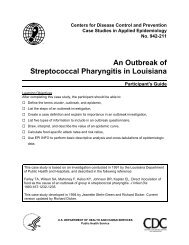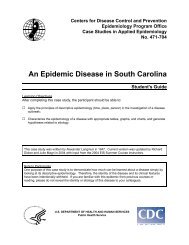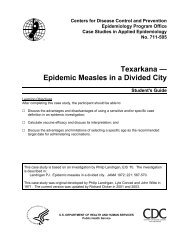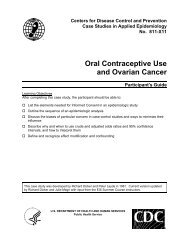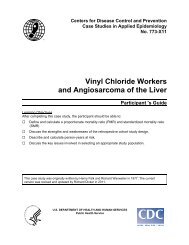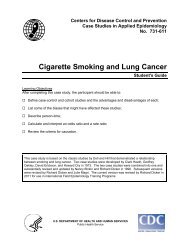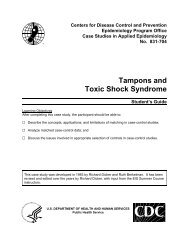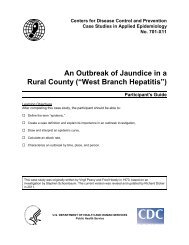No Fair Warning: An Outbreak Following the 1999 ... - Library
No Fair Warning: An Outbreak Following the 1999 ... - Library
No Fair Warning: An Outbreak Following the 1999 ... - Library
Create successful ePaper yourself
Turn your PDF publications into a flip-book with our unique Google optimized e-Paper software.
Centers for Disease Control and PreventionCase Studies in Applied Epidemiology<strong>No</strong>. 000-805<strong>No</strong> <strong>Fair</strong> <strong>Warning</strong>:<strong>An</strong> <strong>Outbreak</strong> <strong>Following</strong> <strong>the</strong><strong>1999</strong> Washington County <strong>Fair</strong>Learning ObjectivesAfter completing this case study, <strong>the</strong> participant should be able to: List <strong>the</strong> reasons to investigate an outbreak; List and discuss each step in <strong>the</strong> investigation of an outbreak; Describe <strong>the</strong> features of an appropriate case definition; and Construct an epidemic curve.Participant’s GuideThis case study is based on <strong>the</strong> investigation of an outbreak following <strong>the</strong> <strong>1999</strong> Washington County(New York) <strong>Fair</strong>. The investigation was conducted by <strong>the</strong> EIS Officers Joel Ackelsberg, Sonja Olsen,and Sumathi Sivapalasingam, staff from <strong>the</strong> New York State Department of Health, several countyhealth departments, and <strong>the</strong> Centers for Disease Control and Prevention.This case study was developed in 2000 by Richard C. Dicker for Tufts University and was last updatedin 2005 with input from <strong>the</strong> 2004 EIS Summer Course instructors.U.S. DEPARTMENT OF HEALTH AND HUMAN SERVICESPublic Health Service
CDC EIS: <strong>No</strong> <strong>Fair</strong> <strong>Warning</strong> (000-805) — Participant’s Guide Page 2PART IOn September 3, <strong>1999</strong>, <strong>the</strong> New York StateDepartment of Health (NYSDOH) receivedreports of at least 7 children hospitalized withbloody diarrhea in counties near Albany, NewYork. At least one of <strong>the</strong> children had developedhemolytic uremic syndrome (HUS), a lifethreateningcomplication, characterized bydestruction of blood cells, damage to <strong>the</strong> lining ofblood vessels, and in severe cases, kidneyfailure.Question 1:If you took <strong>the</strong> call at <strong>the</strong> NYSDOH, what questions would you ask?Question 2:Is this an outbreak?
CDC EIS: <strong>No</strong> <strong>Fair</strong> <strong>Warning</strong> (000-805) — Participant’s Guide Page 5Before departing from Albany and Atlanta, <strong>the</strong>investigators had to make many decisions andpreparations, which could be grouped under <strong>the</strong>headings of Epidemiologic / Scientific Issues;Supplies and Equipment; Investigative TeamComposition, Roles, Responsibilities; andAdministrative Issues.Question 5: Before departing, what preparations and decisions should be made regardinga. <strong>the</strong> epidemiologic / scientific aspects of <strong>the</strong> investigation?b. supplies and equipment?c. investigative team composition, role, responsibilities?d. administrative issues?
CDC EIS: <strong>No</strong> <strong>Fair</strong> <strong>Warning</strong> (000-805) — Participant’s Guide Page 6Over <strong>the</strong> next several days, more and morecases of diarrhea and bloody diarrhea werereported. While <strong>the</strong> earliest cases were inchildren, cases occurred among all age groups.The case-patients did not appear to have anyrestaurant, food, or home or work water supply incommon. However, almost all casesacknowledged attending <strong>the</strong> Washington County<strong>Fair</strong>. The investigators, <strong>the</strong>refore, feltcomfortable focusing on <strong>the</strong> Washington County<strong>Fair</strong> as <strong>the</strong> source of <strong>the</strong> outbreak.Question 6a: What is a case definition?Question 6b: Develop a case definition for this outbreak.Question 7:How might you look for additional cases?
CDC EIS: <strong>No</strong> <strong>Fair</strong> <strong>Warning</strong> (000-805) — Participant’s Guide Page 7PART IIStool samples provided by many ill personsyielded E. coli O157:H7. Investigators decided touse <strong>the</strong> following case definitions:Confirmed case: self-described diarrhea in aperson occurring less than 10 days after havingattended <strong>the</strong> Washington County <strong>Fair</strong>, andisolation from stool of E. coli O157:H7.Suspected case: self-described diarrhea in aperson after having attended <strong>the</strong> WashingtonCounty <strong>Fair</strong>, without isolation from stool of E. coliO157:H7.Within a couple of weeks, 921 persons had beenidentified with reported diarrhea after attending<strong>the</strong> Washington County <strong>Fair</strong>. Stool cultures from129 persons yielded E. coli O157:H7.The investigators decided that <strong>the</strong> next stepshould be to perform descriptive epidemiology,that is, characterize <strong>the</strong> cases by person, time,and place.The median age of cases was 28 years; 58%were female. Among <strong>the</strong> cases, 65 had beenhospitalized. Eleven children had developedhemolytic-uremic syndrome (HUS). Two personsdied — a 3-year-old girl with HUS and a 79-yearoldman with HUS and thromboticthrombocytopenic purpura.For <strong>the</strong> 761 of <strong>the</strong> 921 cases with documenteddates of onset, those dates are shown in <strong>the</strong>table below.To characterize <strong>the</strong> outbreak by time,investigators decided to construct an epidemiccurve.Table 1. Cases of diarrheal illness by dates of onset, Washington County <strong>Fair</strong>, NY, <strong>1999</strong>Onset # confirmed and suspect casesDate Total Confirmed SuspectAugust20 0 0 021 0 0 022 0 0 023 0 0 024 2 0 225 4 0 426 8 0 827 13 0 1328 13 3 1029 41 6 3530 84 11 7331 100 24 76September1 118 42 762 88 30 583 68 15 53Onset # confirmed and suspect casesDate Total Confirmed SuspectSeptember4 61 9 525 44 8 366 36 2 347 26 0 268 19 3 169 8 0 810 10 1 911 3 1 212 8 2 613 4 2 214 2 1 115 0 0 016 0 0 017 1 1 018 0 0 019 0 0 0Total 761 161 600
CDC EIS: <strong>No</strong> <strong>Fair</strong> <strong>Warning</strong> (000-805) — Participant’s Guide Page 8Question 8:What is an epidemic curve?Question 9:Using <strong>the</strong> graph paper provided, graph <strong>the</strong> cases by time of onset of illness (includeappropriate labels and title). Mark <strong>the</strong> dates of <strong>the</strong> fair on <strong>the</strong> epidemic curve.Question 10:Based on <strong>the</strong> epidemic curve and what you know about <strong>the</strong> incubation period, estimatewhen peak exposure likely occurred. What can you conclude from <strong>the</strong> epi curve and<strong>the</strong> likely exposure period?Question 11:What is <strong>the</strong> value of an epidemic curve?
CDC EIS: <strong>No</strong> <strong>Fair</strong> <strong>Warning</strong> (000-805) — Participant’s Guide Page 9
CDC EIS: <strong>No</strong> <strong>Fair</strong> <strong>Warning</strong> (000-805) — Participant’s Guide Page 10The Washington County <strong>Fair</strong> is <strong>the</strong> major annualevent for this rural area east of <strong>the</strong> AdirondackMountains and near <strong>the</strong> Vermont border. It isNew York’s largest agricultural fair, wherehundreds of farm animals and poultry areexhibited. More than 108,000 total visits wererecorded during that week.Question 12:What hypo<strong>the</strong>ses would you want to evaluate?Investigators learned that since <strong>the</strong> fairgroundsoperated only 42 days each year, its watersupply was not considered a public water systemand <strong>the</strong>refore was not regulated as such byei<strong>the</strong>r federal or state law. The fairgrounds weresupplied by shallow wells approximately 20 feetdeep.Environmental investigation of <strong>the</strong> fairgroundsrevealed that much of <strong>the</strong> fair was supplied bychlorinated water. However, in one area of <strong>the</strong>fairgrounds, a shallow well providedunchlorinated water to several vendors who used<strong>the</strong> water to make beverages and ice.Question 13:What epidemiologic approach might you use to evaluate your hypo<strong>the</strong>ses?
CDC EIS: <strong>No</strong> <strong>Fair</strong> <strong>Warning</strong> (000-805) — Participant’s Guide Page 11Part IIIInvestigators decided to conduct a case-controlstudy. The case group consisted of residents ofWashington County who developed diarrheaafter attending <strong>the</strong> fair and who had stoolcultures positive for E. coli.Question 14:Whom might you get for controls?Controls were residents of Washington Countyrandomly selected from <strong>the</strong> telephone book who,upon telephone interview, reported that <strong>the</strong>y hadattended <strong>the</strong> fair. They were selected to have asimilar age distribution as <strong>the</strong> cases.The study included 32 cases and 84 controls. Allof <strong>the</strong> cases had attended <strong>the</strong> fair during its lastfour days, including those who had attended <strong>the</strong>fair only once.Based on analysis of information collected from<strong>the</strong> cases and controls about a wide range ofexposures at <strong>the</strong> fair, <strong>the</strong> investigators were ableto focus on two exposures, as depicted in Tables2 and 3. The data in <strong>the</strong>se tables are limited to<strong>the</strong> 32 cases and 57 controls who attended <strong>the</strong>fair at least once during its final four days.Table 2. Exposure to water from Well #6, Washington County <strong>Fair</strong> outbreak, <strong>1999</strong>Exposure toWell #6 waterCases Controls TotalYes 26 9 35<strong>No</strong> 6 48 54Total 32 57 89Table 3. Exposure to chicken from Vendor A, Washington County <strong>Fair</strong> outbreak, <strong>1999</strong>Exposure toVendor A chickenCases Controls TotalYes 14 5 19<strong>No</strong> 18 52 70Total 32 57 89
CDC EIS: <strong>No</strong> <strong>Fair</strong> <strong>Warning</strong> (000-805) — Participant’s Guide Page 12Question 15:What is <strong>the</strong> appropriate measure of association for a case-control study? Calculate thatmeasure for <strong>the</strong> data in Tables 2 and 3.On multivariate analysis, only one factorremained statistically significantly associatedwith infection — drinking beverages purchasedfrom vendors supplied by water from Well #6.Question 16:If your supervisor wanted you to conduct a retrospective cohort study, how might youdo it? What is <strong>the</strong> appropriate measure of association?
CDC EIS: <strong>No</strong> <strong>Fair</strong> <strong>Warning</strong> (000-805) — Participant’s Guide Page 13As part of <strong>the</strong> environmental investigation,samples of water were tested from Well #6, from<strong>the</strong> distribution pipe to <strong>the</strong> vendor area, and from<strong>the</strong> outlet pipe at <strong>the</strong> vendor area. Although E.coli is infrequently isolated from water supplies,all three sites yielded E. coli O157:H7.Pulse-field gel electrophoresis was done on <strong>the</strong>human and environmental isolates of O157. TheWell # 6 E. coli pattern was indistinguishablefrom <strong>the</strong> patients’ pattern.Investigators looked for sources that might havecontaminated <strong>the</strong> well. They identified two areasof concern — a nearby cattle barn with a manurestorage area, and a dormitory which housedapproximately 80 people who cared for farmanimals during <strong>the</strong> fair. The dorm had bathroomfacilities and shower drains that connected to aseptic tank and <strong>the</strong>n to a seepage pit. Theseepage pit was only 36 feet from Well #6.A thunderstorm had drenched <strong>the</strong> fairgrounds on<strong>the</strong> afternoon of Thursday, August 26.Three weeks after <strong>the</strong> fair ended, red fluorescentdye was flushed down a hole in <strong>the</strong> manurestorage area but was never detected in waterpumped from Well #6. Green fluorescent dyewas flushed down a toilet in <strong>the</strong> dormitory.Within hours, green dye was detected in <strong>the</strong>septic tank, <strong>the</strong> seepage pit, and Well #6 water.Investigators speculated that, given <strong>the</strong> muddyconditions following <strong>the</strong> heavy rains onThursday, cattle manure on boots or clothing of<strong>the</strong> workers who slept in <strong>the</strong> dormitory couldhave washed down <strong>the</strong> floor shower or sinkdrains and entered Well #6. However, <strong>the</strong>investigators could not rule out Well 6 wascontaminated directly by <strong>the</strong> nearby manurestorage site — while <strong>the</strong> fluorescent dye test didnot demonstrate a connection during drywea<strong>the</strong>r, <strong>the</strong> groundwater table may have beenhigher and more easily contaminated following<strong>the</strong> heavy rains.Question 17:What control / prevention measures might you suggest?Question 18:Who needs to know? Why? How might you communicate <strong>the</strong>se findings?
CDC EIS: <strong>No</strong> <strong>Fair</strong> <strong>Warning</strong> (000-805) — Participant’s Guide Page 14ConclusionThis was one of <strong>the</strong> largest outbreaks of E. coliO157:H7 in U.S. history. Based onextrapolations from a household survey ofWashington County residents, perhaps up to5,000 fair attendees may have become ill.The source was an unchlorinated shallow wellthat was not regulated as a public water supply.To prevent similar outbreaks from occurring in<strong>the</strong> future, New York State issued summaryorders to prohibit <strong>the</strong> use of untreated water atcertain agricultural fairs and to require dailytesting and disinfection of water supplies duringpublic events. However, infrequently used watersupplies continue to be unregulated in manyo<strong>the</strong>r states.ReferencesWashington County <strong>Fair</strong> <strong>Outbreak</strong>CDC. <strong>Outbreak</strong> of Escherichia coli O157:H7 and Campylobacter among attendees of <strong>the</strong> WashingtonCounty <strong>Fair</strong> — New York, <strong>1999</strong>. MMWR <strong>1999</strong>;48(36):803-804.Ackelsberg J, Wallace B, Limberger R, et al. A large waterborne outbreak of Escherichia coli O157:H7and Campylobacter jejuni gastroenteritis at a county fair. Submitted.<strong>Outbreak</strong> Investigation, GeneralCDC. Principles of Epidemiology, 2 nd edition. Atlanta: Centers for Disease Control and Prevention,1992.Gregg MB. Conducting a Field Investigation. In: Gregg MB, ed., Field Epidemiology, 2 nd edition. NewYork: Oxford University Press, 2002.E. coliWeb site: http://www.cfsan.fda.gov/~mow/intro.htmlWeb site: http://www.cdc.gov/ncidod/dbmd/diseaseinfo/escherichiacoli_g.htm




